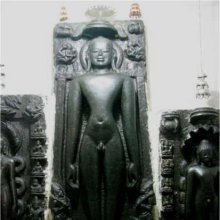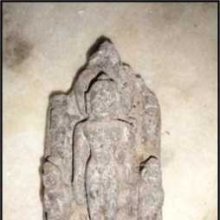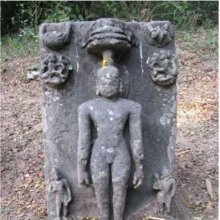Padmaprabha, Padmaprabhā: 14 definitions
Introduction:
Padmaprabha means something in Buddhism, Pali, Hinduism, Sanskrit, Jainism, Prakrit. If you want to know the exact meaning, history, etymology or English translation of this term then check out the descriptions on this page. Add your comment or reference to a book if you want to contribute to this summary article.
Images (photo gallery)
In Hinduism
Kavya (poetry)
Source: Wisdom Library: KathāsaritsāgaraPadmaprabhā (पद्मप्रभा), daughter of Mahādaṃṣṭra, is one of the five Vidyādhara maidens vowed to take Naravāhanadatta as a husband, as mentioned in the Kathāsaritsāgara, chapter 108. Accordingly, “... and he [Naravāhanadatta] saw those maidens with a blazing fire in front of them; and Vāyuvegayaśas, after dragging them away from it, said to the king: ‘[...] and this fourth is Padmaprabhā, the daughter of Mahādaṃṣṭra [...] and I am the fifth; all we five, when we saw you performing asceticism in the domain of the Siddhas, were bewildered with love...’”.
The Kathāsaritsāgara (‘ocean of streams of story’), mentioning Padmaprabhā, is a famous Sanskrit epic story revolving around prince Naravāhanadatta and his quest to become the emperor of the vidyādharas (celestial beings). The work is said to have been an adaptation of Guṇāḍhya’s Bṛhatkathā consisting of 100,000 verses, which in turn is part of a larger work containing 700,000 verses.

Kavya (काव्य, kavya) refers to Sanskrit poetry, a popular ancient Indian tradition of literature. There have been many Sanskrit poets over the ages, hailing from ancient India and beyond. This topic includes mahakavya, or ‘epic poetry’ and natya, or ‘dramatic poetry’.
Jyotisha (astronomy and astrology)
Source: academia.edu: Tessitori Collection I (astronomy)Padmaprabha (पद्मप्रभ) or Padmaprabhasūri is the author of the Bhuvanadīpaka (classified as literature dealing with astronomy, astrology, divination, medicine), which is included in the collection of manuscripts at the ‘Vincenzo Joppi’ library, collected by Luigi Pio Tessitori during his visit to Rajasthan between 1914 and 1919.—Padmaprabha-sūri, a member of the nāgapurīya branch of the tapāgaccha and a pupil of Devasūri, wrote it in VS 1221 (= 1164 CE). Several authors, Jain and non-Jain, commented upon this work.

Jyotisha (ज्योतिष, jyotiṣa or jyotish) refers to ‘astronomy’ or “Vedic astrology” and represents the fifth of the six Vedangas (additional sciences to be studied along with the Vedas). Jyotisha concerns itself with the study and prediction of the movements of celestial bodies, in order to calculate the auspicious time for rituals and ceremonies.
In Buddhism
Tibetan Buddhism (Vajrayana or tantric Buddhism)
Source: Wisdom Library: Tibetan BuddhismPadmaprabhā (पद्मप्रभा) refers to one of the female Śrāvakas mentioned as attending the teachings in the 6th century Mañjuśrīmūlakalpa: one of the largest Kriyā Tantras devoted to Mañjuśrī (the Bodhisattva of wisdom) representing an encyclopedia of knowledge primarily concerned with ritualistic elements in Buddhism. The teachings in this text originate from Mañjuśrī and were taught to and by Buddha Śākyamuni in the presence of a large audience (including Padmaprabhā).

Tibetan Buddhism includes schools such as Nyingma, Kadampa, Kagyu and Gelug. Their primary canon of literature is divided in two broad categories: The Kangyur, which consists of Buddha’s words, and the Tengyur, which includes commentaries from various sources. Esotericism and tantra techniques (vajrayāna) are collected indepently.
In Jainism
General definition (in Jainism)
Source: Wisdom Library: JainismPadmaprabha (पद्मप्रभ):—The sixth Tīrthaṅkara (Janism recognizes 24 such teachers or Siddhas). He is also known as Padmaprabhanātha. His colour is red (rakta), according to Aparājitapṛcchā (221.5-7). His height is 250 dhanuṣa (a single dhanuṣa (or, ‘bow’) equals 6 ft), thus, roughly corresponding to 457 meters. His emblem, or symbol, is a Padma.
Padmaprabha’s father is Dhara according to Śvetāmbara but Dharaṇa according to Digambara and his mother is Susīmā. It is an ancient Jain practice to worship the Tīrthaṅkara’s parents in various rites, such as the pratiṣṭhāvidhi, according to the Ācāradinakara (14th century work on Jain conduct written by Vardhamāna Sūri).
Source: archive.org: The Jaina IconographyPadmaprabha (पद्मप्रभ) refers to the sixth of twenty-four Tīrthaṃkaras or Jinas, commonly depicted in Jaina iconography.—The books of Jainism assign to the sixth Tīrthaṃkara Padmaprabha the cihna or iconographic cognizance of a red lotus. His Kevala tree is called the Chatrābha. The attendant spirits are named Kusuma and Śyāmā (Digambara: Manovegā). The chowri-bearer, generally the contemporary king, is Yamadyuti by name.
We are informed by the Jaina Purāṇas of both sects that his native place is Kauśāmbī. His father’s [mother’s?] name is known as Susīmā. Two interpretations of his name [Padmaprabha] are given. First, his colour was of a red lotus, hence the name. Second, his mother, while the Jina was in her womb, expressed a desire to sleep upon abed of red lotuses, which was fulfilled. This originated the name. His symbolism is just expressive of the same fact. The name of Yakṣa attendant Kusuma connected with him means flower and leads support to the very idea.
Source: archive.org: TrisastisalakapurusacaritraPadmaprabha (पद्मप्रभ) refers to the sixth of the twenty-four Tīrthaṅkaras praised in the first book (ādīśvara-caritra) [chapter 1] of Hemacandra’s 11th century Triṣaṣṭiśalākāpuruṣacaritra: an ancient Sanskrit epic poem narrating the history and legends of sixty-three illustrious persons in Jainism.
Accordingly, “[...] we worship the Arhats, who at all times and all places purify the people of the three worlds by their name, representation, substance, and actual existence. [...] May the splendor of the Lord Padmaprabha’s body, red as if from a burst of anger in crushing internal enemies, promote your emancipation”.
Padmaprabha is the son of Dhara and Susīmā, according to chapter 3.4, “[...] After nine months, seven and a half days, on the twelfth day of the black half of Kārtika, the moon being in Citrā, the planets suddenly going to exaltation by retrograde and accelerating motions, the Queen bore a son, red lotus-color, marked by a red lotus (i.e., padma). [...] Because his mother had a pregnancy-whim for a couch of lotuses while he was still in her womb and because of his lotus-color, Ms father named him Padmaprabha. Being cherished by nurses from heaven, playing with gods in the form of boys, the Master grew up gradually, and attained the second period of life”.

Jainism is an Indian religion of Dharma whose doctrine revolves around harmlessness (ahimsa) towards every living being. The two major branches (Digambara and Svetambara) of Jainism stimulate self-control (or, shramana, ‘self-reliance’) and spiritual development through a path of peace for the soul to progess to the ultimate goal.
Languages of India and abroad
Sanskrit dictionary
Source: Cologne Digital Sanskrit Dictionaries: Edgerton Buddhist Hybrid Sanskrit DictionaryPadmaprabha (पद्मप्रभ).—(1) name of (a future birth of Śāriputra as) a Buddha-to-be, predicted: Saddharmapuṇḍarīka 65.5 ff.; (2) name of a devaputra, one of the 16 guardians of the bodhimaṇḍa: Lalitavistara 277.15.
--- OR ---
Padmaprabhā (पद्मप्रभा).—(1) name of a mythical city: Gaṇḍavyūha 232.8; (2) name of a queen: Gaṇḍavyūha 335.21.
Source: Cologne Digital Sanskrit Dictionaries: Shabda-Sagara Sanskrit-English DictionaryPadmaprabha (पद्मप्रभ).—m.
(-bhaḥ) The sixth Jina or Jaina pontiff. E. padma a lotus, and prabha who shines. kamalasadṛśaprabhānviteca .
Source: Cologne Digital Sanskrit Dictionaries: Monier-Williams Sanskrit-English Dictionary1) Padmaprabha (पद्मप्रभ):—[=padma-prabha] [from padma] m. Name of a future Buddha
2) [v.s. ...] of a Deva-putra, [Lalita-vistara]
3) [v.s. ...] of 6th Arhat of present Avasarpiṇī, [cf. Lexicographers, esp. such as amarasiṃha, halāyudha, hemacandra, etc.]
4) [v.s. ...] (with sūri) of an author, [Catalogue(s)]
5) Padmaprabhā (पद्मप्रभा):—[=padma-prabhā] [from padma-prabha > padma] f. Name of a daughter of Mahā-daṃṣṭra, [Kathāsaritsāgara]
Source: Cologne Digital Sanskrit Dictionaries: Yates Sanskrit-English DictionaryPadmaprabha (पद्मप्रभ):—[padma-prabha] (bhaḥ) 1. m. 6th Jaina pontiff.
Source: DDSA: Paia-sadda-mahannavo; a comprehensive Prakrit Hindi dictionary (S)Padmaprabha (पद्मप्रभ) in the Sanskrit language is related to the Prakrit word: Paumappaha.
[Sanskrit to German]
Sanskrit, also spelled संस्कृतम् (saṃskṛtam), is an ancient language of India commonly seen as the grandmother of the Indo-European language family (even English!). Closely allied with Prakrit and Pali, Sanskrit is more exhaustive in both grammar and terms and has the most extensive collection of literature in the world, greatly surpassing its sister-languages Greek and Latin.
Kannada-English dictionary
Source: Alar: Kannada-English corpusPadmaprabha (ಪದ್ಮಪ್ರಭ):—[noun] the sixth of the twenty four Tīrthaṃkaras, the Jaina spiritual teachers.
Kannada is a Dravidian language (as opposed to the Indo-European language family) mainly spoken in the southwestern region of India.
See also (Relevant definitions)
Partial matches: Padma, Prabha.
Starts with: Padmaprabha suri, Padmaprabhanatha, Padmaprabhasuri.
Full-text (+18): Dhara, Patmappirapar, Patumappirapar, Kusuma, Susima, Maharatnapratimandita, Viraja, Paumappaha, Padmaprabha suri, Acyuta, Pushpayaksha, Chatrabha, Yamadyuti, Grahabhavaprakasha, Dharana, Kaushambi, Brahmasthala, Kalpakashaya, Bhuvanapradipaka, Somadeva.
Relevant text
Search found 11 books and stories containing Padmaprabha, Padmaprabhā, Padma-prabha, Padma-prabhā; (plurals include: Padmaprabhas, Padmaprabhās, prabhas, prabhās). You can also click to the full overview containing English textual excerpts. Below are direct links for the most relevant articles:
Trishashti Shalaka Purusha Caritra (by Helen M. Johnson)
Part 8: Padmaprabha’s omniscience < [Chapter IV - Padmaprabhacaritra]
Part 16: Padmaprabha’s mokṣa (emancipation) < [Chapter IV - Padmaprabhacaritra]
Invocation < [Chapter IV - Padmaprabhacaritra]
Jainism in Odisha (Orissa) (by Ashis Ranjan Sahoo)
Padmaprabha image, Padmavati Thakurani, Narendrapur < [Chapter 3: Survey of Jaina Antiquities in Odisha]
Jaina Antiquities in Hatamala (Cuttack) < [Chapter 3: Survey of Jaina Antiquities in Odisha]
Jaina Antiquities in Narasinghapur (Cuttack) < [Chapter 3: Survey of Jaina Antiquities in Odisha]
Jain Remains of Ancient Bengal (by Shubha Majumder)
Images of Tīrthaṅkara Padmaprabha < [Chapter 6 - Iconographic Study of Jaina Sculptural Remains]
Uncertain Tīrthaṅkaras < [Chapter 6 - Iconographic Study of Jaina Sculptural Remains]
Images of Tīrthaṅkara Neminātha < [Chapter 6 - Iconographic Study of Jaina Sculptural Remains]
Stupas in Orissa (Study) (by Meenakshi Chauley)
Uddiyana Pitha (in Tantric Buddhism) < [Chapter 2]
Kalpa-sutra (Lives of the Jinas) (by Hermann Jacobi)
Bhagavati-sutra (Viyaha-pannatti) (by K. C. Lalwani)
Part 3 - On patriarchs < [Chapter 5]


